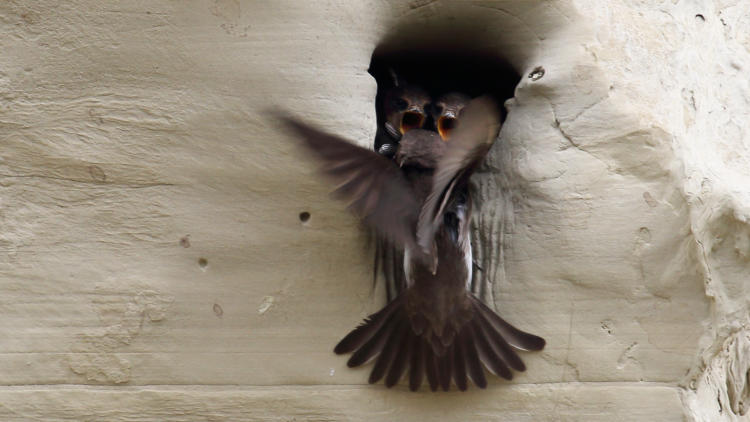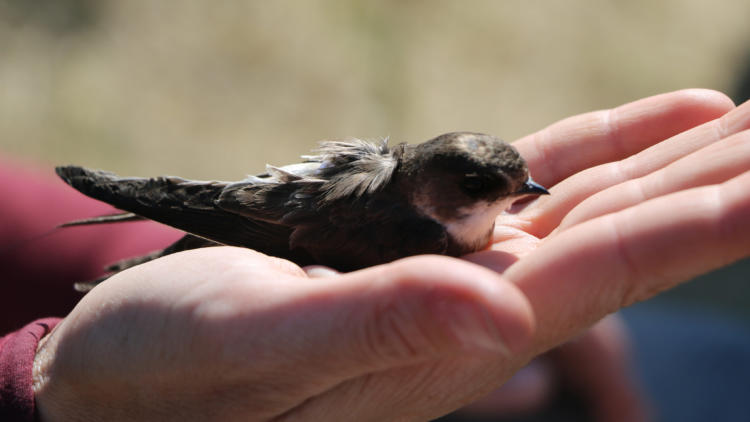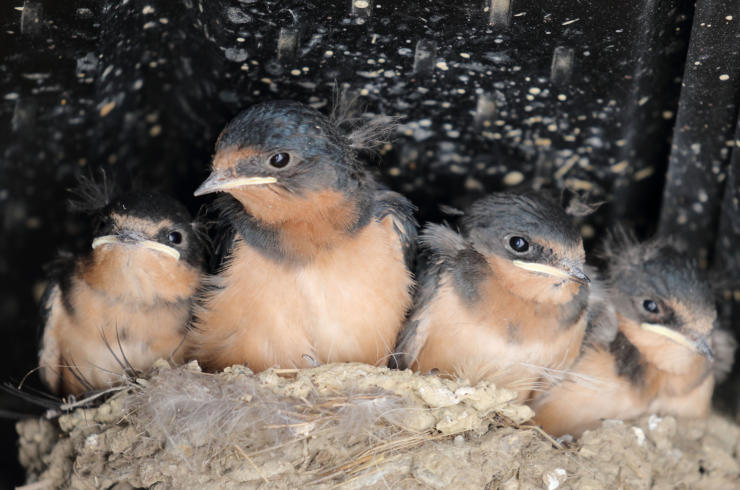In late July, a fledgling bank swallow emerges from its burrow in a steep cliff alongside the Columbia Wetlands. Shortly after it first takes flight, likely within days or weeks, this young swallow will begin a journey that could take it as far south as Chile for the winter. But exactly where bank swallows from the Columbia Valley spend their winters — and which route they follow for roughly 10,000 kilometres — is a mystery for scientists who study the birds.
Answers to those questions could help us understand why populations of bank swallows in Canada have plunged by 98% over the last four decades. The global crash in insect numbers is likely part of the problem, but what about habitat destruction, climate change or pesticides? Knowing where bank swallows spend the rest of their lives is a first step to finding out why their numbers have fallen so quickly and what we could do to help them recover.
It’s with those questions in mind that Wildsight Golden’s contract biologist Rachel Darvill, working with Environment and Climate Change Canada, fitted 100 adult bank swallows with tiny tracking devices over the past two years. When the swallows pass within about 15km of a Motus Wildlife Tracking Station, their location will be recorded in a database, eventually painting a clearer picture of the travels of Columbia Valley bank swallows.

But for right now, our young bank swallow is headed out on the hunt for food. Bank swallows, who weigh only about 14 grams, feast on the many insects that emerge from the Columbia Wetlands, swallowing hundreds of insects per day. These swallows move so quickly that it’s a real challenge for Rachel and her 70-strong crew of volunteers to get an accurate count of active nests at breeding colonies as they fly in and out of their burrows.
Bank swallows, along with their close relatives barn swallows, are a designated species at risk in Canada. Scientists at Environment and Climate Change Canada have expanded the project, aiming to tag 50 swallows from each province in the country this year as part of a project looking to evaluate migratory connectivity for bank swallows throughout Canada.
To help narrow their winter location down further, because Motus tracking stations are not equally distributed throughout the America’s, the bank swallow tagging teams across Canada have also collected tail feathers from the same tagged swallows. By analyzing the isotopes of common elements like carbon, hydrogen and nitrogen found in them, which vary in environmental concentrations from north to south, scientists will be able to get a general idea of where the birds regrew those feathers when they molted during their time in South America.
The hope is that within the next year once all the data has been analyzed, we’ll know a lot more about bank swallow migration patterns.

The Columbia Valley has excellent habitat for bank swallows, with steep cut banks of soil that’s soft enough for swallows to dig burrows, but cohesive enough to make a safe home. Male swallows tunnel up to 1.8m deep into the bank and then males and females build a nest at the end. Rachel and her crew have identified about 100 breeding colonies between Canal Flats and Donald, many with hundreds of burrows each, leading to the protection of these banks as critical habitat under the federal Species at Risk Act.
While Wildsight Golden has built or is working on eight large wooden nesting structures for barn swallows, creating new homes for bank swallows isn’t as straightforward — so protecting existing colony sites is crucial. Rachel is working to do just that, including a project with BC Parks to re-route a hiking trail at Windermere Lake Provincial Park that passed right through a colony and another project with the District of Invermere to protect and improve an old earthworks pile that swallows have taken up residence in. With bank swallow populations having already fallen so much, we can’t afford to destroy their homes, even in colonies outside their normal habitat.

Rachel’s team’s data has already shown some important results. Many volunteers are either expert birders or have been trained to recognize the subtle differences between a bank swallow and a similar-looking northern rough-winged swallow, who also nest in bank burrows. Thanks to the work of these volunteers, who collect data by observing swallows in their colonies, we know that the numbers of bank swallows nesting at colonies in the area is usually lower than expected, though we don’t know exactly why. They’ve also observed that none of the 50 swallows they marked with a band last year came back to the same colony this year, though Rachel wonders if this is because they understandably didn’t like being caught in a mist net — or if something more might be happening.
This year’s cohort of 50 tracked swallows begin their long journey south in July, pinging the tracking stations that Rachel’s team have installed along the Columbia Wetlands for the last time. If all goes to plan, their tiny tracking devices, weighing just a third of a gram, will be picked up through the US, south into Mexico and then through Central and South America. Protecting all the habitat they need to thrive could require international cooperation from Canada to Chile and every important habitat in between. We’ll be hoping that the these swallows journeys will help us learn more about them, so we can help recover their populations in the Columbia Valley — and across the Americas.
Wildsight Golden thanks their funders for the Upper Columbia Swallow Habitat Enhancement Project including the Columbia Basin Trust, the Fish & Wildlife Compensation Program, the RDEK Columbia Valley Local Conservation Fund, BC Parks, and the Province of BC plus their many partners, including the Ktunaxa Nation, the Shuswap Band, Environment and Climate Change Canada, the Lake Windermere District Rod & Gun Club, and the Lake Windermere Ambassadors.
If you’d like to volunteer to help bank and barn swallows in the Columbia Valley, contact swallows@wildsight.ca.










